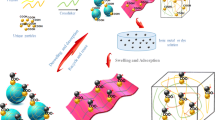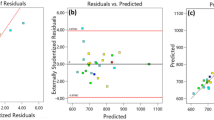Abstract
Reactive dyes are extremely toxic and harmful to the environment even present at very low concentration. In this study, sodium alginate based reusable hydrogels was prepared for the removal of methylene blue from waste water. pH-tunable hydrogels was prepared by the introduction of ionic pendant functionalities on sodium alginate (SA) by the utilization of ethylene glycol and acrylic acid through condensation followed by free radical polymerization. The structure, formation and thermal stability of hydrogel was identified by Fourier transform infra red spectroscopy and thermogravimetric analysis respectively. Swelling nature at different pH ranges and the humidity contents of both dried and dye adsorbed hydrogels was investigated. The morphology of the dry and dye adsorbed hydrogel was also studied using scanning electron microscopy. The swelling studies infer that pronounced swelling obtained at higher pH than at lower pH. The surface morphology of plain hydrogel before and after adsorption of methylene blue (MB) was examined by SEA analysis. The adsorption tendency of the SEA hydrogel in MB was steadily investigated at different pH, contact time, concentration dye and adsorbent dosage. All prepared hydrogels were performed well in the removal of MB from waste water up to 80–98%. Recycling of hydrogels has a vital role for waste water treatment and it can be done by desorption studies which shows that 0.1 N HCl revealed higher elution efficiency i.e. 90.00%. Furthermore, adsorption–desorption studies suggested that SA based hydrogels contributes to enhance the removal efficacy, which renders the hydrogels well-designed for the efficient removal of cationic dyes (MB). However, polyol based hydrogels have been chosen for an adsorbent because of low-cost, ecofriendly, biocompatible and efficient biosorbents.
Graphical Abstract












Similar content being viewed by others
References
Franklin DS, Guhanathan S (2015) Simple, convenient, low-cost, and solventless greener way to pH-responsive polymeric hydrogels: synthesis and characterization. J Appl Polym Sci 132:41921. https://doi.org/10.1002/app.4192
Franklin DS, Guhanathan S (2014) Performance of silane coupling agent treated hydroxyapatite/diethylene glycol-based pH-sensitive biocomposite hydrogels. Iran Polym J 23:809–817
Dhanapal V, Subramanian K (2014) Modified chitosan for the collection of reactive blue 4, arsenic and mercury from aqueous media. Carbohydr Polym 108:65–74
Sudarsan S, Franklin DS, Sakthivel M, Guhanathan S (2016) Non toxic, antibacterial, biodegradable hydrogels with pH-stimuli sensitivity: investigation of swelling parameters. Carbohydr Polym 148:206–215
Huj K, Alsberg E, Kaiglu D, Lee KY, Money DJ (2004) Degradation of hydrogel via the size of crosslinking junction. Adv Mater 16:1917–1921
Bendtsen ST, Wei M (2015) Synthesis and characterization of a novel injectable alginate–collagen–hydroxyapatite hydrogel for bone tissue regeneration. J Mater Chem B 3:3081. https://doi.org/10.1039/c5tb00072f
Draga AE (2014) Design and applications of interpenetrating neutral hydrogel. Chem Eng J 243:572–590
Liu P, Jiang L, Zhu L, Guo J, Wang A (2015) Novel covalently cross-linked attapulgite/poly(acrylicacid-coacrylamide) hybrid hydrogels by inverse suspension polymerization: synthesis optimization and evaluation as adsorbents for toxic heavy metals. J Ind Eng Chem 23:188–193
Mandal B, Ray SK (2013) Synthesis of interpenetrating network hydrogel from poly(acrylic acid-co-hydroxyethyl methacrylate) and sodium alginate: modeling and kinetics study for removal of synthetic dyes from water. Carbohydr Polym 98:257–269
Sakthivel M, Franklin DS, Sudarsan S, Chitra G, Guhanathan S (2016) Investigation on pH-switchable (itaconic acid/ethylene glycol/acrylic acid) based polymeric biocompatible hydrogel. R Soc Chem Adv 6:106821–106831
Franklin DS, Guhanathan S (2015) Influence of chain length of diol on the swelling behavior of citric acid based pH sensitive polymeric hydrogels: a green approach. J Appl Polym Sci 131:41403. https://doi.org/10.1002/app.41403
Bujans B, Martınez FR, Ortiz P (2003) Structural characterization of oligomers from the polycondensation of citric acid with ethylene glycol and long-chain aliphatic alcohols. J Appl Polym Sci 88:302–306
Mittal H, Parashar V, Mishra SB, Mishra AK (2014) Fe3O4 MNPs and gum xanthan based hydrogels nanocomposites for the efficient capture of malachite green from aqueous solution. Chem Eng J 255:471–482
Shoueira KR, Sarhana AA, Mohamdy Attab A, Akla MA (2016) Macrogel and nanogel networks based on crosslinked poly (vinyl alcohol) for adsorption of methylene blue from aqua system. Environ Nanotechnol Monit Manag 5:62–73
Karnjkar YS, Dinde RM, Dinde NM, Bawankar KN, Hinge SP, Mohod AV, Gogate PR (2015) Degradation of magenta dye using different approaches based on ultrasonic and ultraviolet irradiations: comparison of effectiveness and effect of additives for intensification. Ultrason Sonochem 27:117–124
Karthiga Devi G, Senthil Kumar P, Sathish Kumar K (2016) Green synthesis of novel silver nanocomposite hydrogel based on sodium alginate as an efficient biosorbent for the dye wastewater treatment: prediction of isotherm and kinetic parameters. Desalin Water Treat. https://doi.org/10.1080/19443994.2016.1178178
Mahmoud GA, Mohamed SF, Hassan HM (2014) Removal of methylene blue dye using biodegradable hydrogel and reusing in a secondary adsorption process. Desalin Water Treat. https://doi.org/10.1080/19443994.2014.905978
Samandari S, Samandari S, Nezafati N, Yahya K (2014) Efficient removal of lead(II) ions and methylene blue from aqueous solution using chitosan/Fe-hydroxyapatite nanocomposite beads. J Environ Manag 146:481–490
Franklin DS, Guhanathan S (2015) Investigation of citric acid-glycerol based pH-sensitive biopolymeric hydrogels for dye removal applications: a green approach. Ecotoxicol Environ Saf 121:80–86
Wang J, Ying X, Liu J, Li X, Zhang X (2015) Controlled mechanical and swelling properties of urethane acrylate grafted calcium alginate hydrogels. Int J Biol Macromol 81:11–16
Thangam FG, Muthu J (2014) Alginate based hybrid copolymer hydrogels—influence of pore morphology on cell-materials interaction. Carbohydr Polym 12:235–244
Zano OC, Esposito VD, Acierno S, Amrosio MR, Caro CD, Rurso CP, Miro A, Ungaro F, Calignano A, Formisano P, Quaglia F (2015) Alginate–hyaluronan composite hydrogels accelerate wound healing process. Carbohydr Polym 131:407–414
Lencina MMS, Tolino AE, Anrewcetti AN, Villar MA (2015) Thermo responsive hydrogels based on alginate-g-poly(N-isopropyl acrylamide) copolymers obtained by low doses of gamma radiation. Eur Polym J 68:641–649
Bruchet M, Melman A (2015) Fabrication of patterned calcium cross-linked alginate hydrogel films and coatings through reductive cations exchange. Carbohydr Polym 131:57–64
Battacharya R, Ray SK (2015) Adsorption of industrial dyes by semi-IPN hydrogels of acrylic copolymers and sodium alginate. J Ind Eng Chem 22:92–102
Leung IW (2001) Ecotoxicology of glutaraldehyde: review of environmental fate and effect of studies. Ecotoxicol Environ Saf 49:26–39
Bajpai SK, Pradeep D, Singh Saggu SP (2015) Investigation of moisture sorption, permeability, cytotoxicity and drug release behavior of carrageenan/poly vinyl alcohol films. J Macromol Sci A 52:243–251
Malekbala MR, Khan MA, Hosseini S, Abdullah LC, Thomas SY, Choong SY (2015) Adsorption/desorption of cationic dye on surfactant modified mesoporous carbon coated monolith: equilibrium, kinetic and thermodynamic studies. J Ind Eng Chem 21:369–377
Zhang Z, Wang W, Wang A (2015) High-pressure homogenization associated hydrothermal process of palygorskite for enhanced adsorption of methylene blue. Appl Surf Sci 329:306–314
Srivatstava KP, Kumar A (2002) UV-visible spectrophotometric studies of methylene blue dye with selected polar solvents. Orient J Chem 18(3)
Nho YC, Lim YM, Lee YM (2004) Preparation, properties and applications of pH sensitive poly (ethylene oxide) PEO hydrogel grafted with acrylic acid (AA), using gamma irradiation. Radiat Phys Chem 7:239–242
Sudarsan S, Franklin DS, Guhanathan S (2015) Influence of ethylene oxide units on pH and salt responsibility of sodium alginate biopolymeric hydrogels-by Greener approach. Int J Front Sci 2:88–99
Franklin DS, Guhanathan S (2014) Synthesis and characterization of citric acid-based pH-sensitive biopolymeric hydrogels, Polym Bull 71(1):93–110
Leal D, Borggraeve WD, Encin MN, Matshrio B (2013) Preparation and characterization of hydrogels based on homo polymeric fractions of sodium alginate and PNIPAAm. Carbohydr Polym 92:157–166
Leal D, Matsuhiro B, Rossi M, Caruso F (2008) FT-IR spectra of alginic acid block fractions in three species of brown seaweeds. Carbohydr Res 4:308–316
Sudarsan S, Franklin DS, Guhanathan S (2015) Imbibed salts and pH-responsive behaviours of sodium alginate based eco-friendly biopolymeric hydrogels—a solventless approach. Macromol Int J 11:24–29
Bajpai SK, Chand N, Mahendra M (2012) The adsorptive removal of cationic dye from aqueous solution using poly (methacrylic acid) hydrogels. Int. J Environ Sci 2:1609–1624
Cheng HL, Feng QH, Liew CA, Liu Y, Wu DB, Wang QG (2016) Removal of MB with hemicelluloses/clay hybrid hydrogels. Chin J Polym Sci 34:709–719
Zhou C, Wu Q, Lei T, Negulescu II (2014) Adsorption kinetic and equilibrium studies for methylene blue by partially hydrolyzed polyacrylamide/cellulose nanocrystal nanocomposite hydrogels. Chem Eng J 251:17–24
Sun L, Yu H, Fugetsu B (2012) Effect of encapsulated graphene oxide on alginate-based bead adsorption to remove acridine orange from aqueous solutions. J Hazard Mater 101:203–204
Tally M, Atassi Y (2016) Synthesis and characterization of pH-sensitive superabsorbent hydrogels based on sodium alginate-g-poly(acrylic acid-co-acrylamide) obtained via an anionic surfactant micelle templating under microwave irradiation, Polym Bull. https://doi.org/10.1007/s00289-016-1649-8
Kalyani S, Smith B, Sridhar S, Krishnaiah A (2008) Pervaporation separation of ethanol–water mixtures through sodium alginate membranes. Desalination 229:68–81
Isiklan N, Kubalc G (2012) Microwave-induced synthesis of alginate-graft-poly(N-isopropyl acrylamide) and drug release properties of dual pH- and temperature-responsive beads. Eur J Pharm Biopharm 82:316–331
Zendehdel M, Barati A, Alikhani H, Hekmat A (2010) Removal of methylene blue from waste water by adsorption onto semi-interpenetrating polymer network hydrogels composed of acrylamide and acrylic acid copolymer and polyvinyl alcolol. Iran J Environ Health Sci Eng 7:423–428
Wang Y, Wang W, Wang A (2013) Efficient adsorption of MB on an alginate based nano composite hydrogels organo illite/smectite clay. Chem Eng J 228:132–139
Ghorai S, Sarkar A, Raoufi M, Panda AS, Schonherr H (2014) Enhanced removal of methylene blue and methyl violet dyes from aqueous solution using a nanocomposite of hydrolyzed polyacrylamide grafted xanthan gum and incorporated nanosilica. ACS Appl Mater Interface Sci 6:4766–4777
Salisu A, Sanagi MM, Naim AA, Juhanniabd K (2015) Removal of methylene blue dye from aqueous solution using alginate grafted polyacrylonitrile beads. Der Pharma Chem 7:237–242
Shenvi BSS, Isloor AM, Ismail AF, Shilton SJ, Al Ahmed A (2015) Humic acid based biopolymeric membrane for effective removal of methylene blue and rhodamine. Ind Eng Chem Res 54:4965–4975
Ma T, Chang PR, Zhang P, Zhao F, Ma X (2014) Fabrication of ultra-light graphene-based gels and their adsorption of methylene blue. Chem Eng J 240:595–600
Li C, Lu J, Li S, Tong Y, Ye B (2017) Synthesis of magnetic microsphere with sodium alginate and activated carbon for removal of MB. Materials 10:84
Dinu MV, Lazar MM, Dragan ES (2017) Dual ionic cross-linked alginate/clinoptilolite composite microbeads with improved stability and enhanced sorption properties for methylene blue. React Funct Polym 116:31–40
Senthikumar S, Varadarajan PR, Porkodi K, Subbharaan CV (2005) Adsorption of MB onto jute fiber carbon; kinetics and equilibrium studies. J Colloid Interface Sci 284:78–82
Senthikumar S, Kalaamani P, Porkodi K, Varadarajan PR, Subbharaan CV (2006) Adsorption of dissolved reactive red dye from aqueous phase onto activated carbon prepared from agricultural waste. Bioresour Technol 97:1618–1625
Shour KR, Sarhan AA, Atta AM, Akl MA (2015) Macrogel and nanogel network based on crosslinked poly(vinyl alcohol) for adsorption of MB from aqua system. Environ Nanotechnol Monit Manag 5:62–73
Acknowledgements
One of the authors, Mr. S.Sudarsan, gratefully acknowledges the authorities of C. Abdul Hakeem College of Engineering and Technology, Melvisharam, Tamil Nadu, India for providing laboratory facilities.
Author information
Authors and Affiliations
Corresponding author
Rights and permissions
About this article
Cite this article
Sudarsan, S., Franklin, D.S., Sakthivel, M. et al. Ecofriendly pH-Tunable Hydrogels for Removal of Perilous Thiazine Dye. J Polym Environ 26, 3773–3784 (2018). https://doi.org/10.1007/s10924-018-1258-8
Published:
Issue Date:
DOI: https://doi.org/10.1007/s10924-018-1258-8




